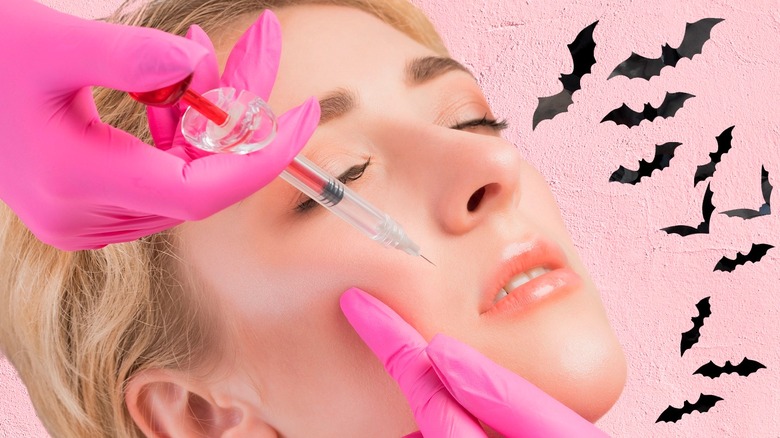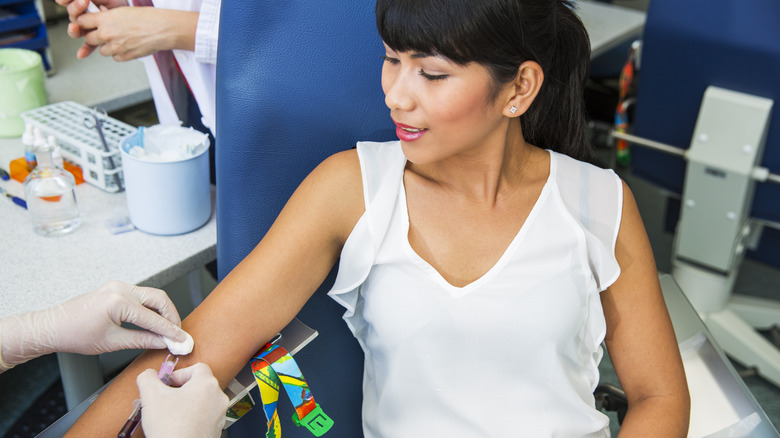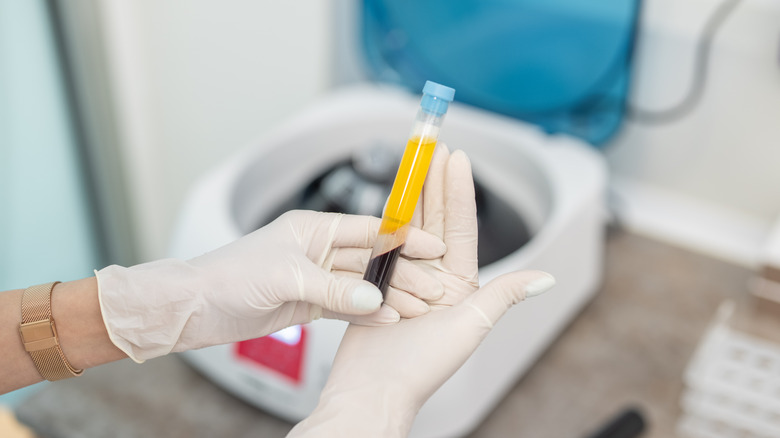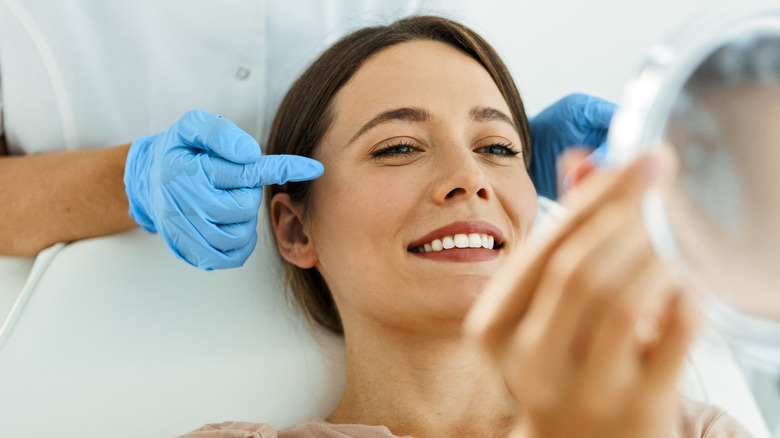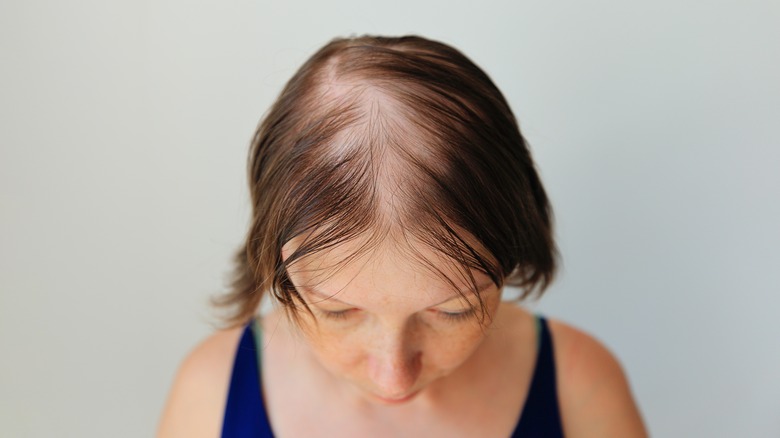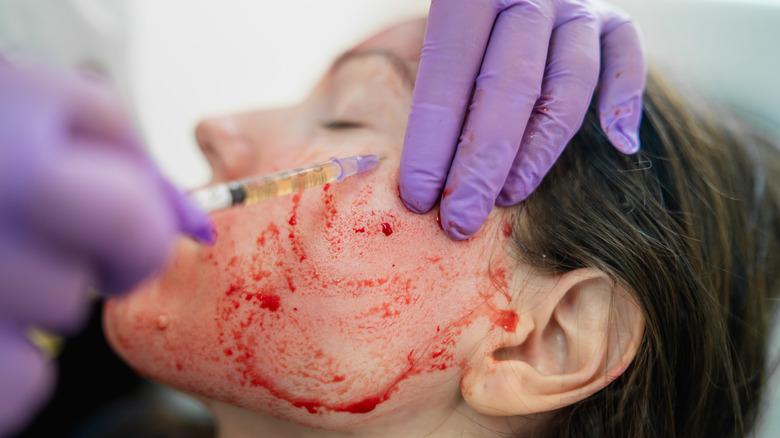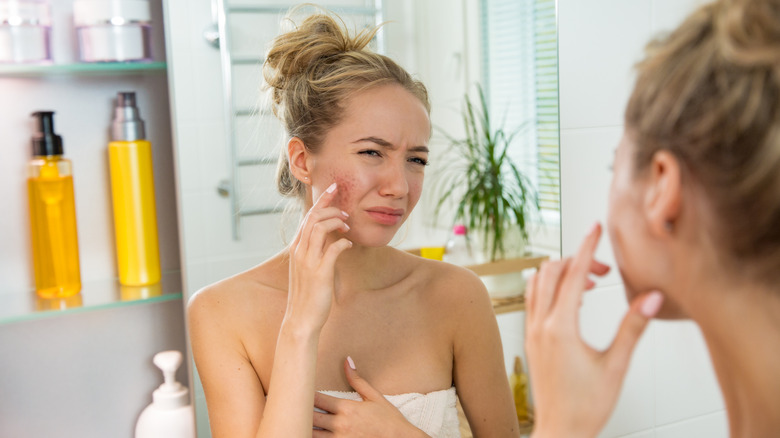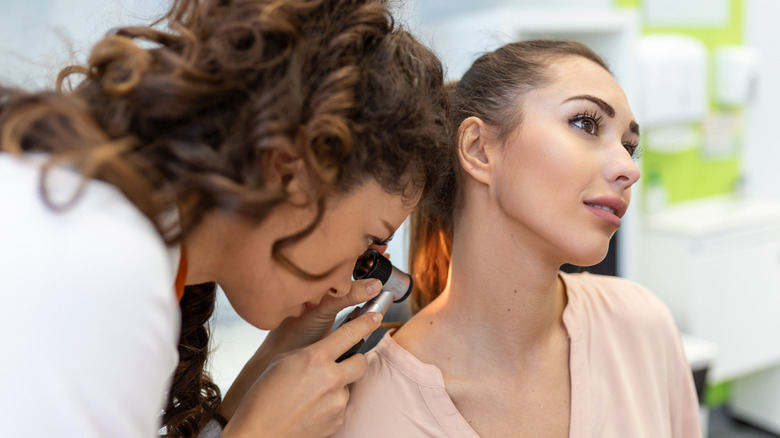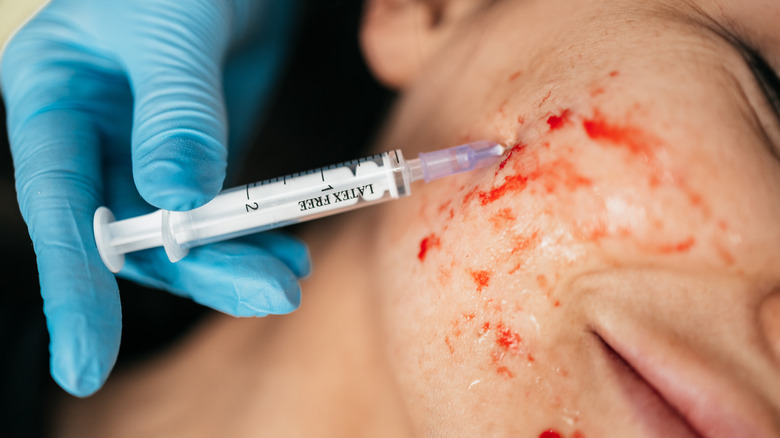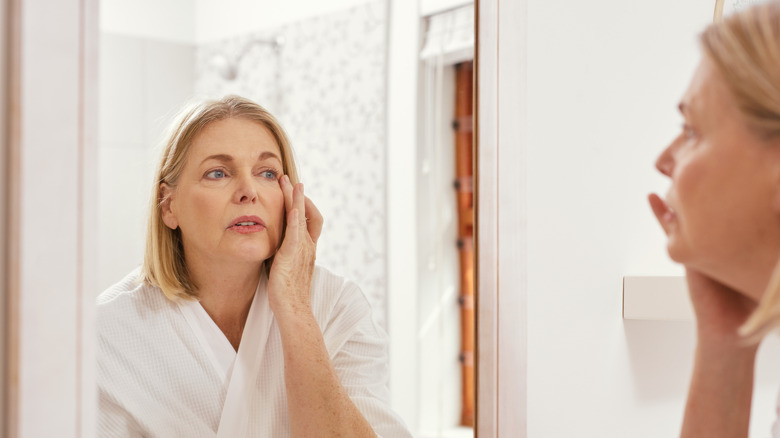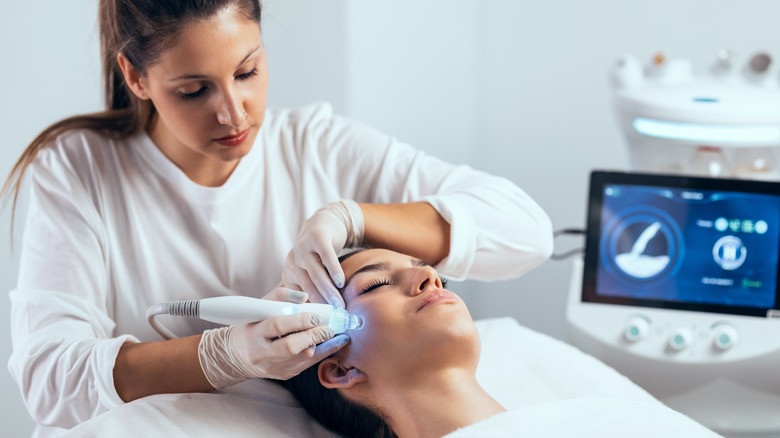PRP Facials: Everything To Know Before Getting The 'Vampire' Treatment
Content warning: The following article contains some graphic images related to PRP facials.
You might have already seen the pictures of red-faced influencers touting the latest viral trend – the vampire facial. However, this treatment has actually been around for a while. Its official name, PRP, is short for platelet-rich plasma, and as the name implies, it involves the use of a person's blood (hence the "vampire" nickname) as the main ingredient in this facial. It might sound unusual, to say the least, but it's been a developing treatment since the early 20th century, back when clinicians were experimenting with its wound healing powers (in a 2021 historical review per the Journal of Cosmetic Dermatology).
It began in the realm of transfusiology, or what we'd call the early art of blood transfusions. Today, it's a dermatological treatment used for a variety of conditions, including hair loss and damaged skin repair. It's even a recommended course of treatment for issues like mobility injuries and torn tendons, depending on what you're after, per WebMD.
We'll look at how the PRP facial works for skin, what to expect with this treatment, and what the costs are to be made into a temporary "vampire."
What are PRP facials?
The term PRP has become a sort of all-inclusive term for blood-related injectables. The basics of PRP, per the American Academy of Dermatology, include having blood extracted from the arm and undergoing a process "that separates the platelets from the rest of your blood." Then the platelet-rich blood is reinjected into the treatment area.
However, in a 2021 article in the Biology Journal, this is one of three methods for rejuvenating bone and facial tissues using the technique of platelet extraction. Platelets are tiny disc-shaped cells that help with clotting and wound healing. Using different methods, different concentrations of blood platelets can be utilized (per the Biology Journal). To extract the platelets from the rest of the blood requires the process of centrifugation. Essentially, after clinicians take the person's blood, they spin it around at high speed, separating the blood into layers (per ScienceDirect), and this lets them extract the part of the blood that's most rich in platelets. The resulting solution, high in growth factor hormones, is what you'll get injected with.
How do PRP facials work?
So why do they want to get this growth factor hormone? Basically, growth factor hormones are molecules that promote cell growth, according to the National Institutes of Health. The body produces a number of these different hormones, which get secreted into the blood and can help create new tissues and repair damage.
By using concentrated platelets containing these growth hormones, this can stimulate cell proliferation or an increase in cells (which is slowed in aging or damaged skin), helping to regenerate the structure of the skin and activate collagen production. Collagen synthesis is important because it maintains the skin's structure, which can help keep our skin elastic and firm, per Harvard School of Public Health.
As we age, our body loses collagen, but we can also exacerbate this process when we're exposed to the sun. According to 2021 research in the Journal of Aesthetic Nursing, this type of damage affects our skin's natural protective barrier. And unfortunately, that can trigger signs of premature aging, like wrinkles, sagging, and pigmentation. But PRP can aid in stimulating repair on multiple levels, which can make skin appear younger and heal damage to its barrier.
The benefits of PRP facials
There have been various studies on the efficacy of PRP to aid the appearance of photoaging. For instance, a 2021 review and trial in the Acta Biomedica Journal using the Glogau skin score found highly successful results looking at patients in a six-month trial before and after treatment. The Glogau scoring system developed by Richard Glogau is a scale that runs from 1 to 4, to demonstrate the different stages of photoaging.
In the trial, they looked at moisture levels (a sign of a healthy skin barrier), wrinkling, pore sizes, sun spots (from sun damage), skin elasticity, and the appearance of dark circles around the eyes. Patients and physicians used a scan to judge the changes. The results after six months and two treatments showed some general improvement all around, but the most significant change was in the appearance of wrinkles, particularly around the eyes and nose, and with some notable changes in under-eye circles.
In conjunction with this, a few other similar studies were cited. In these studies, similar effects were reported, with improvements in skin tightness, the appearance of wrinkles, and dark circles. Other areas — such as moisture, pore size, and sun spots — showed less promising results, but given the minimally invasive nature of the treatment, it was still considered successful.
PRP for hair loss
In addition to PRP's encouraging results for skin, it's also a treatment for alopecia, a disease that causes hair loss. Although the causes of hair loss are not fully understood, it's thought to be the result of the immune system mistakenly attacking hair follicles, according to the National Institutes of Health. This can cause changes in density and hair health.
In "Hair Transplant Surgery and Platelet Rich Plasma," PRP has been shown to promote new hair follicle development, increase hair density, and help with regrowth. This is believed to work because of the growth hormones in the concentrated blood platelets. They activate certain signals in the cells related to the hair's growth and stimulate the development of new blood vessels, affecting circulation. As a result, this can help to mitigate the inflammation caused by the immune system around the scalp, which is present in alopecia.
One of the additional benefits of PRP over other hair loss treatments, such as a transplant or invasive procedure, is that there are very few complications with a PRP treatment. Like the facial, they inject the platelet concentration into the scalp. There's practically no downtime, and patients can return to work the next day.
The drawbacks of PRP facials
With any injection-based treatment, there's likely to be some soreness. In the Acta Biomedica Journal study, though there was overall success, not all candidates were able to stick the trial out to the end. Some complained that the pain was too severe, and others suffered from bruising at the injection site for several days — with one person fainting during the procedure. This is likely because the skin around the face is thinnest, particularly around the eyes, an area which is more prone to bruising, according to Healthline.
WebMD warns to expect some "temporary redness, inflammation, and bruising." If you experience anything more severe, like an infection, scarring, or excessive bleeding, it may be a red flag that the facial wasn't performed correctly. This is why it's crucial to choose a medical professional to perform the procedure. Remember also that results aren't guaranteed, and you'll likely require additional treatment to maintain the effects.
The American Academy of Dermatology has also noted some other minor side effects (mainly in the case of PRP for hair loss but could be applicable to the facial as well), such as inflammation, itching, and potential allergic reactions like rashes and fever.
Are there any long-term side effects of PRP facials?
Long-lasting or severe side effects of PRP are extremely rare. A 2018 study of over 2,000 PRP studies found only one serious incident, and this was caused by poor practice, not the PRP procedure itself (per the Aesthetic Plastic Surgery Journal). Side effects like swelling, redness, and pain around the injection site should subside on their own. The more pertinent issue with PRP facials is the lack of consensus on their efficacy.
For instance, of the 2,000 studies mentioned in the review, though most saw positive results, it isn't fully understood why. Another issue is that between these studies, the way the PRP was prepared, its concentration, and the controls that they were tested against varied significantly, so there was a general lack of standardization.
This could present a problem in understanding long-term effects since there isn't a systematic way of monitoring the results over time. In the study referenced above, the longest observation time appears to be one year. However, it could be argued that if there were serious long-term side effects, we likely would have seen them by now, as PRP has been around since the '40s.
Who can and can't have a PRP facial?
Since PRP involves blood, there are a few people who the treatment won't be suitable for. According to orthopedic specialist Dr. Harris, if you have anemia, a blood clotting disorder, or an infection, you may not be able to have PRP. You'll also probably be ineligible if you are on blood thinners or currently breastfeeding or pregnant.
The 2021 research in the Acta Biomedica Journal also rules out people with immune system disorders, or anyone with serious conditions like cancer, diabetes, or heart issues. Those who have a background that may slow the healing process — such as alcoholism, malnutrition, or drug abuse — are also not good candidates. If you've recently had a skin treatment or used anything that affects collagen synthesis — including retinol, chemical peels, and certain fillers — you may need to wait a sufficient time for the skin to heal before having PRP.
If you are generally in good health and not on certain medications, you'll likely be a good candidate. But of course, your practitioner should do a thorough medical history before giving you the okay. Since most PRP results focus on aging, it's debatable whether it'd be helpful for other skin concerns like acne or hyperpigmentation.
Expectations and preparations for treatment
PRP is not a substitute for proper skincare. Though it's a well-tolerated and quick procedure, its effects are generally short-term. In a 2021 Journal of Aesthetic Plastic Surgery review of the efficacy of PRP, there's little evidence that you'll get better results than with a saline filler treatment. Moreover, the results point to little improvements in the skin's barrier (i.e., increased barrier function or moisture retention), suggesting the effects are probably superficial. Nevertheless, many people say they feel their skin looks better after the treatment, but such assertions are subjective. In short, you should be realistic about what to expect when getting this facial.
No specific preparation is needed, but staying hydrated and eating well can improve blood quality. Numbing cream will be applied before the treatment. Bleeding and discomfort may occur but should subside. The treatment generally spans six months, with monthly treatments required for the first three and less frequent maintenance treatments afterward.
After the treatment, you can't take any blood thinning medication (including aspirin and ibuprofen) for at least six hours. You should also avoid anything that could irritate the skin, such as sun exposure, steaming, makeup, harsh chemicals, or further skincare treatments within 72 hours after the procedure, per PRP Injection MD. Instead, give your skin plenty of time to recover and apply an ice pack if you experience any pain. However, for any serious concerns or severe discomfort, you should always consult your doctor.
How long does it take to get results?
The Center for Surgical Dermatology (CSD) estimates that results can appear in just a few weeks, though they become more noticeable after six months. Some people may get results faster or slower depending on their current health and if they've had other treatments. You can usually opt for either injections or micro-needling (though this costs more) to apply the PRP. In the case of micro-needling, the CSD notes that the results are usually faster and more notable.
The rate at which you start to see results depends on your body's natural regenerative ability. As Metro Dermatology explains, older patients may need more time for the treatment to show results, and results are not permanent. They'll have to be followed up with additional treatments to maintain the effect. On average, though, the treatment can last for up to one to two years.
While it's unknown how many treatments it'll take for the results to last this long, it's likely that you'll see final effects after the full treatment course of about six months. It's best to ask your doctor specifically, since some report that ongoing treatment is needed to maintain effects.
The cost of PRP facials
The cost of a PRP facial will depend on location, number of sessions, the areas you get done, as well as the type of PRP. For instance, Dr. PRP USA estimates that a single injection can cost between $400 and $1,500 but explains that follow-up procedures are sometimes cheaper than the first appointment.
However, the service comparison site Thervo puts this slightly higher at $900 to $2,500 (or an average of $1,300), with the main differences in pricing accounting for micro-needling, with the injectables themselves being around the $500 mark. They also note that prices may be higher in a city like Los Angeles but cheaper in Austin, Texas.
There may also be consultation fees depending on which clinic you visit. Health insurers typically won't cover an elective or voluntary cosmetic procedure like a PRP facial, so you should expect to pay out of pocket. You should also keep in mind that listed prices are usually just for one session. To get the best results, at least three sessions is the recommended standard. Some clinics do offer bundles at a discount if you pay for multiple sessions upfront, while others expect you to pay the same amount for each.
How to get the best results with PRP
PRP works best with other dermatological treatment pairings, such as micro-needling or fillers. In fact, many clinics will offer micro-needling with PRP. However, you can just get PRP on its own and have it injected into target areas. Dermatologist Dr. Dray explains when we combine PRP with micro-needling, it can increase the uptake of platelets and help deliver them to the areas of the skin with structural tissues, such as collagen.
As for getting PRP with fillers, "Aesthetic Surgery Journal" Volume 41 reports that a combination containing hyaluronic acid provides better results for skin elasticity than PRP alone. Hyaluronic acid injectables are a type of dermal filler that can help hydrate the skin and minimize the appearance of fine lines, per the American Society for Dermatologic Surgery. And when combined with PRP, this seems to have a synergistic effect in helping boost the underlying skin structure, giving a rejuvenated and sculpted look.
Dr. Dray also suggests that PRP can be combined with or used after a resurfacing, where you remove skin layers to trigger regrowth. When combined, the treatments may help enhance the outcome of these procedures, possibly leading to better results.
